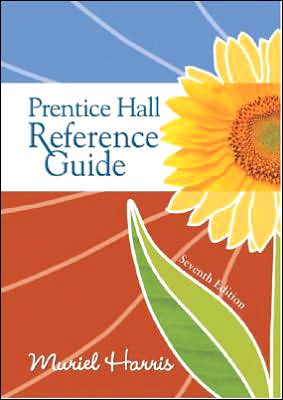Prentice Hall Reference Guide
Muriel Harris was the director of the Purdue Writing Center where she worked elbow-to-elbow with students for over twenty-five years. Based on her experience assisting thousands of writing students, she authored the Prentice Hall Reference Guide with several goals in mind. The handbook is brief, with the most concise explanations possible. It is tabbed for ease of use, enabling students to quickly find what they’re looking for. And, it features the foundational teaching tools she developed...
Search in google:
Muriel Harris was the director of the Purdue Writing Center where she worked elbow-to-elbow with students for over twenty-five years. Based on her experience assisting thousands of writing students, she authored the Prentice Hall Reference Guide with several goals in mind. The handbook is brief, with the most concise explanations possible. It is tabbed for ease of use, enabling students to quickly find what they’re looking for. And, it features the foundational teaching tools she developed during her tenure at the writing center: the innovative Question and Correct and Compare and Correct features. These features address the challenges that student writers face in an accessible, easy-to-use manner. The streamlined and user-friendly organization and innovative student-focused features make the Prentice Hall Reference Guide the easiest handbook for students–and instructors–to use.
Table of Contents Prentice Hall Reference Guide, 7th Edition by Muriel Harris Tab 1 Question & Correct/ Compare & Correct/ Try This Tab 2 Writing Processes 1. Thinking about Writing a. Rhetorical Triangle b. Topic c. Audience d. Purpose e. Medium f. Thesis 2. Writing Processes and Strategies a. Planning b. Drafting c. Organizing d. Collaborating e. Revising f. Editing and Proofreading 3. Paragraphs a. Unity b. Coherence c. Development d. Introductions and Conclusions e. Organization patterns 4. Argument a. Reading and Writing Arguments b. Considering the Audience c. Finding a Topic d. Developing Your Argument e. Recognizing and Avoiding Fallacies f. Organizing Your Argument 5. Visual Argument a. Similarities and Differences between Written and Visual Arguments b. Appeals in Visual Argument c. Logical Fallacies in Visual Argument d. Writing Visual Arguments 6. Document Design a. Principles of Document Design b. Incorporating Visuals c. Paper Preparation d. Multimedia Presentations e. Web Page Design Tab 3 Common Categories of Writing 7. Writing Essay Exams 8. Writing About Literature a. Ways to Write About Literature b. Writing the Assignment c. Conventions in Writing About Literature d. A Sample Paper 9. Professional Writing a. Memos b. E-Mail Communications c. Business Letters d. Cover Letters e. Résumés f. Newsletters and Brochures 10. Writing Portfolios Tab 4 Revising Sentences 11. Comma Splices and Fused Sentences 12. Subject-Verb Agreement 13. Sentence Fragments 14. Dangling and Misplaced Modifiers 15. Parallel Constructions 16. Consistency (Avoiding Shifts) 17. Faulty Predication 18. Coordination and Subordination 19. Sentence Clarity 20. Transitions 21. Sentence Variety Tab 5 Parts of Sentences 22. Verbs 23. Nouns and Pronouns 24. Pronoun Case and Reference 25. Adjective and Adverbs 26. Prepositions 27. Subjects 28. Phrases 29. Clauses 30. Essential and Nonessential Clauses and Phrases 31. Sentences Tab 6 Style and Word Choice 32. Style versus Grammar 33. General and Specific Language a. General versus Specific Statements b. General versus Specific Words c. Concrete versus Abstract Words 34. Conciseness and Wordiness 35. Passive versus Active Voice 36. Unnecessary and Inappropriate Words a. Cliches b. Pretentious Language c. Offensive Language 37. Appropriate Language a. Standard English b. Formality Levels c. Emphasis d. Denotation and Connotation e. Colloquialisms, Slang, and Regionalisms f. Jargon and Technical Terms 38. Nonsexist Language a. Alternatives to Man b. Alternative Job Titles c. Alternatives to the Male or Female Pronoun Tab 7 Punctuation 39. Commas 40. Apostrophes 41. Semicolons 42. Colons 43. Quotation Marks 44. Hyphens 45. End Punctuation 46. Other Punctuation Tab 8 Mechanics and Spelling 47. Capitals 48. Abbreviations 49. Numbers 50. Underlining/Italics 51. Spelling Tab 9 ESL and Multilingual Writers 52. American Style in Writing 53. Verbs 54. Omitted Words 55. Repeated Words 56. Count and Noncount Nouns 57. Adjectives and Adverbs 58. Prepositions 59. Idioms Tab 10 Research 60. Finding a Topic a. Deciding on a Purpose and Audience b. Deciding on a Topic c. Narrowing a Topic d. Formulating a Research Question e. Formulating a Thesis 61. Searching for Information a. Choosing Primary and Secondary Sources b. Searching Libraries and Library Databases c. Searching the Internet d. Searching Other Sources 62. Using Web Resources 63. Evaluating Sources a. Getting Started b. Evaluating Internet Sources c. Evaluating Bibliographic Citations d. Evaluating Content 64. Collecting Information a. Keeping Notes on a Computer b. Printing and Annotating Photocopies and Printouts c. Starting a Working Bibliography d. Writing Notecards 65. Using Sources and Avoiding Plagiarism a. Understanding Why Plagiarism is Wrong b. Recognizing Plagiarism and Documenting Sources Responsibly c. Summarizing without Plagiarising d. Paraphrasing without Plagiarising e. Using Quotation Marks to Avoid Plagiarizing f. Using Signal Words and Phrases to Integrate Sources 66. Writing the Research Paper a. Getting Started b. Planning and Organizing c. Writing a Draft d. Reviewing the Draft e. Revising, Editing, and Checking the Format Tab 11 MLA Documentation 67. Documenting in MLA Style a. In-text Citations b. Endnotes c. Works Cited List d. Sample MLA-style Research Paper Tab 12 APA and Other Documentation 68. Documenting in APA Style a. In-text Citations b. Footnotes c. References List d. Sample APA-style Research Paper 69. Documenting in Other Styles a. Chicago Manual of Style (CMS) b. Council of Science Editors (CSE) c. Resources for Other Styles








